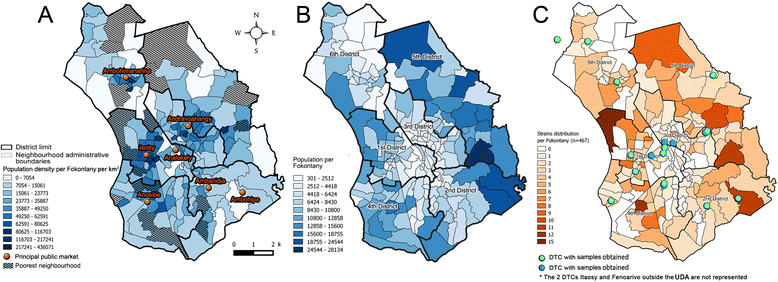Assessment of tuberculosis spatial hotspot areas in Antananarivo, Madagascar, by combining spatial analysis and genotyping
- PMID: 28806916
- PMCID: PMC5557477
- DOI: 10.1186/s12879-017-2653-9
Assessment of tuberculosis spatial hotspot areas in Antananarivo, Madagascar, by combining spatial analysis and genotyping
Abstract
Background: Tuberculosis (TB) remains a public health problem in Madagascar. A crucial element of TB control is the development of an easy and rapid method for the orientation of TB control strategies in the country. Our main objective was to develop a TB spatial hotspot identification method by combining spatial analysis and TB genotyping method in Antananarivo.
Methods: Sputa of new pulmonary TB cases from 20 TB diagnosis and treatment centers (DTCs) in Antananarivo were collected from August 2013 to May 2014 for culture. Mycobacterium tuberculosis complex (MTBC) clinical isolates were typed by spoligotyping on a Luminex® 200 platform. All TB patients were respectively localized according to their neighborhood residence and the spatial distribution of all pulmonary TB patients and patients with genotypic clustered isolates were scanned respectively by the Kulldorff spatial scanning method for identification of significant spatial clustering. Areas exhibiting spatial clustering of patients with genotypic clustered isolates were considered as hotspot TB areas for transmission.
Results: Overall, 467 new cases were included in the study, and 394 spoligotypes were obtained (84.4%). New TB cases were distributed in 133 of the 192 Fokontany (administrative neighborhoods) of Antananarivo (1 to 15 clinical patients per Fokontany) and patients with genotypic clustered isolates were distributed in 127 of the 192 Fokontany (1 to 13 per Fokontany). A single spatial focal point of epidemics was detected when ignoring genotypic data (p = 0.039). One Fokontany of this focal point and three additional ones were detected to be spatially clustered when taking genotypes into account (p < 0.05). These four areas were declared potential TB transmission hotspots in Antananarivo and will be considered as priority targets for surveillance in the future.
Conclusion: This method, combining spatial analysis and TB genotyping will now be used for further focused clinical and epidemiological studies in Madagascar and will allow better TB control strategies by public health authorities.
Keywords: Antananarivo; Genotyping; Geographic Information System; Mycobacterium tuberculosis; Spatial cluster.
Conflict of interest statement
Ethics approval and consent to participate
The study was approved by the ethics committee of the Malagasy Ministry of Public Health (Authorization No: 057MSANP/EC – 04th July 2013).
Consent for publication
Not applicable.
Competing interests
The authors declare that they have no competing interests.
Publisher’s Note
Springer Nature remains neutral with regard to jurisdictional claims in published maps and institutional affiliations.
Figures




References
-
- WHO . Global Tuberculosis report 2015. 2015.
-
- WHO . WHO Report 2014. Global tuberculosis control 2014. 2014.
-
- Demay C, Liens B, Burguiere T, Hill V, Couvin D, Millet J, et al. SITVITWEB--a publicly available international multimarker database for studying Mycobacterium tuberculosis genetic diversity and molecular epidemiology. Infect Genet Evol. 2012;12(4):755–766. doi: 10.1016/j.meegid.2012.02.004. - DOI - PubMed
-
- Brudey K, Driscoll JR, Rigouts L, Prodinger WM, Gori A, Al-Hajoj SA, et al. Mycobacterium tuberculosis complex genetic diversity: mining the fourth international spoligotyping database (SpolDB4) for classification, population genetics and epidemiology. BMC Microbiol. 2006;6:23. doi: 10.1186/1471-2180-6-23. - DOI - PMC - PubMed
MeSH terms
LinkOut - more resources
Full Text Sources
Other Literature Sources

